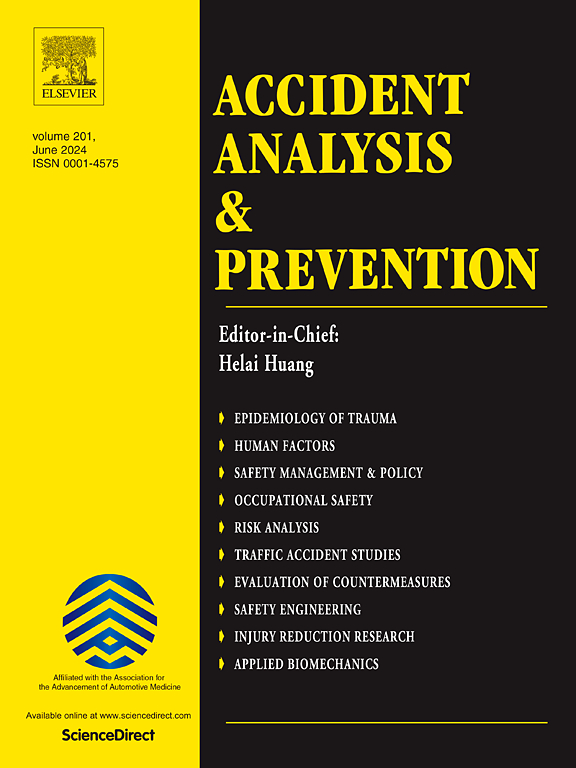Evaluating the effectiveness of rhythmic visual guidance technology for mitigating driving risks in highway tunnel groups: A simulation study
IF 5.7
1区 工程技术
Q1 ERGONOMICS
引用次数: 0
Abstract
Driving in highway tunnel groups necessitates frequent adaptation to drastic changes in the traffic environment, thereby increasing driving difficulty and risk. This study integrates drivers’ preferences for rhythmic information with the inherent rhythmic characteristics of tunnel group structures to propose a new and adaptive method to mitigate driving risks using rhythmic visual guidance (RVG) technology. Unlike traditional visual guidance systems, which often rely on static signals, RVG utilizes dynamic, rhythmically varying cues to capture drivers’ attention and improve situational awareness more effectively. By employing principles of fuzzy mathematics, the study quantifies the applicability of various rhythmic forms in visual guidance technology and establishes priority application principles for undulating and staggered rhythms. After verifying the accuracy of the simulation model, the effectiveness of RVG technology in mitigating driving risks in highway tunnel groups was analyzed using lateral offset, driving speed, and vehicle acceleration as evaluation metrics. The findings reveal that RVG technology significantly reduces vehicle lateral offset and enhances drivers’ perception and control of tunnel sidewalls and driving trajectories. This effect is particularly pronounced under limited lighting conditions or in large tunnel groups with extended driving distances. Regardless of whether the lighting level is set at 0% or 100% of the standard brightness, the implementation of RVG results in reduced vehicle driving speeds. The variation in the 25th to 75th percentile distribution of driving speeds was insignificant, demonstrating that RVG technology effectively regulates driving speed and is not significantly affected by lighting conditions. Furthermore, when the lighting level is set at 100% of the standard brightness, the 25th to 75th percentile distribution interval of driving speeds is [89.576, 102.416], indicating the highest and least stable driving speeds suggests that blindly increasing tunnel lighting levels not only raises operating costs but may also adversely affect driving safety. This study provides novel insights into applying dynamic visual cues for highway tunnel groups’ traffic operation and safety management. It has significant practical engineering value for guiding the low-carbon design of tunnel groups.
评价节奏视觉引导技术在公路隧道群中降低驾驶风险的有效性:仿真研究。
在高速公路隧道群中驾驶需要频繁适应交通环境的急剧变化,从而增加了驾驶难度和风险。本研究将驾驶员对有节奏信息的偏好与隧道群结构固有的节奏特点相结合,提出了一种利用有节奏视觉引导(RVG)技术降低驾驶风险的自适应新方法。与通常依赖静态信号的传统视觉引导系统不同,RVG 利用动态、有节奏变化的提示来吸引驾驶员的注意力,并更有效地提高态势感知能力。这项研究利用模糊数学原理,量化了视觉引导技术中各种节奏形式的适用性,并确定了起伏和交错节奏的优先应用原则。在验证了仿真模型的准确性后,以横向偏移、行驶速度和车辆加速度为评价指标,分析了 RVG 技术在高速公路隧道群中降低驾驶风险的有效性。研究结果表明,RVG 技术可显著减少车辆横向偏移,增强驾驶员对隧道侧壁和行驶轨迹的感知和控制。在照明条件有限或驾驶距离较长的大型隧道群中,这种效果尤为明显。无论照明水平设置在标准亮度的 0% 还是 100% 上,RVG 的实施都会降低车辆的行驶速度。行驶速度的第 25 百分位数到第 75 百分位数分布的变化并不明显,这表明 RVG 技术能有效调节行驶速度,并且不受照明条件的显著影响。此外,当照明水平设定为标准亮度的 100%时,行车速度的第 25 到 75 百分位数分布区间为 [89.576, 102.416],表明行车速度最高和最不稳定,这表明盲目提高隧道照明水平不仅会增加运营成本,还可能对行车安全产生不利影响。这项研究为高速公路隧道群的交通运营和安全管理应用动态视觉提示提供了新的见解。它对指导隧道群的低碳设计具有重要的工程实用价值。
本文章由计算机程序翻译,如有差异,请以英文原文为准。
求助全文
约1分钟内获得全文
求助全文
来源期刊

Accident; analysis and prevention
Multiple-
CiteScore
11.90
自引率
16.90%
发文量
264
审稿时长
48 days
期刊介绍:
Accident Analysis & Prevention provides wide coverage of the general areas relating to accidental injury and damage, including the pre-injury and immediate post-injury phases. Published papers deal with medical, legal, economic, educational, behavioral, theoretical or empirical aspects of transportation accidents, as well as with accidents at other sites. Selected topics within the scope of the Journal may include: studies of human, environmental and vehicular factors influencing the occurrence, type and severity of accidents and injury; the design, implementation and evaluation of countermeasures; biomechanics of impact and human tolerance limits to injury; modelling and statistical analysis of accident data; policy, planning and decision-making in safety.
 求助内容:
求助内容: 应助结果提醒方式:
应助结果提醒方式:


